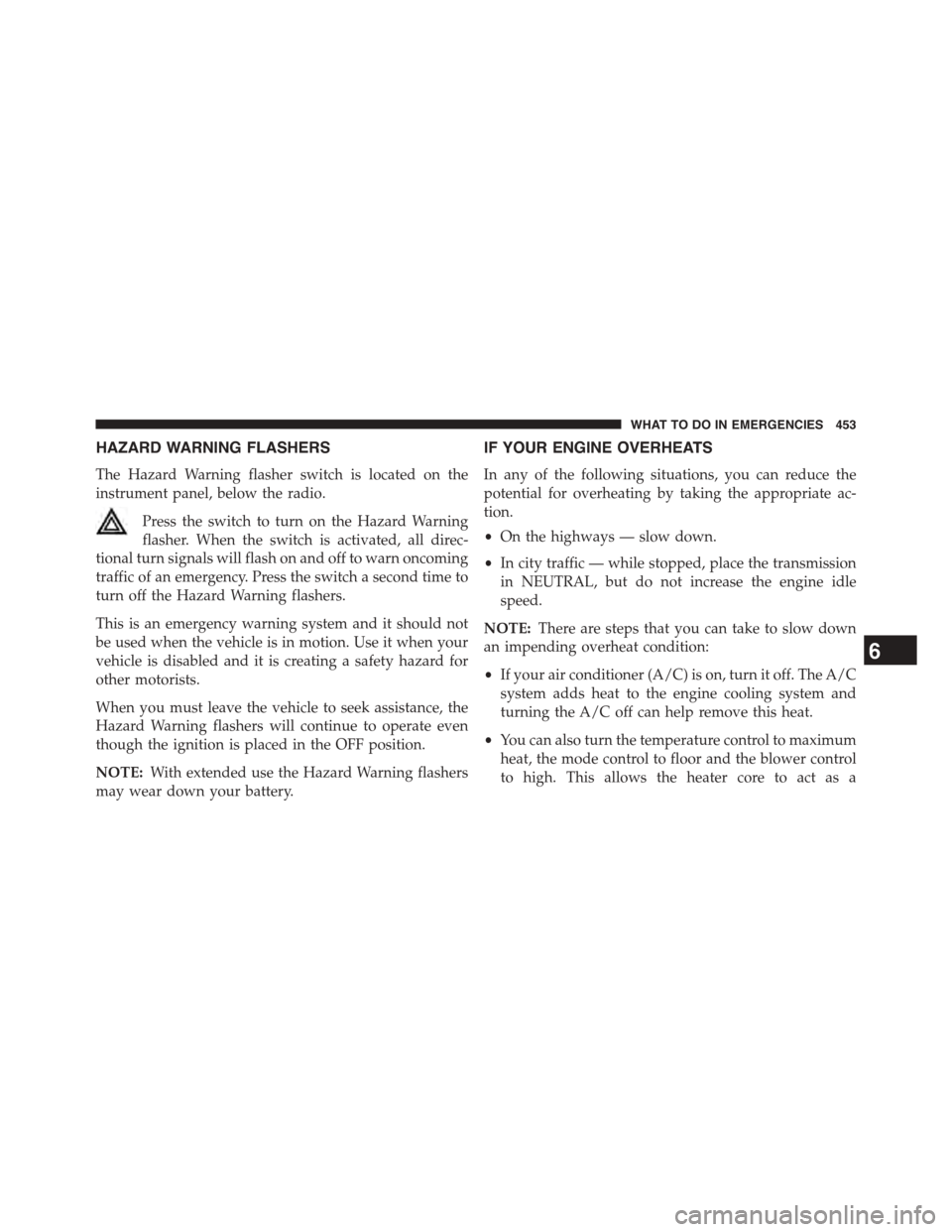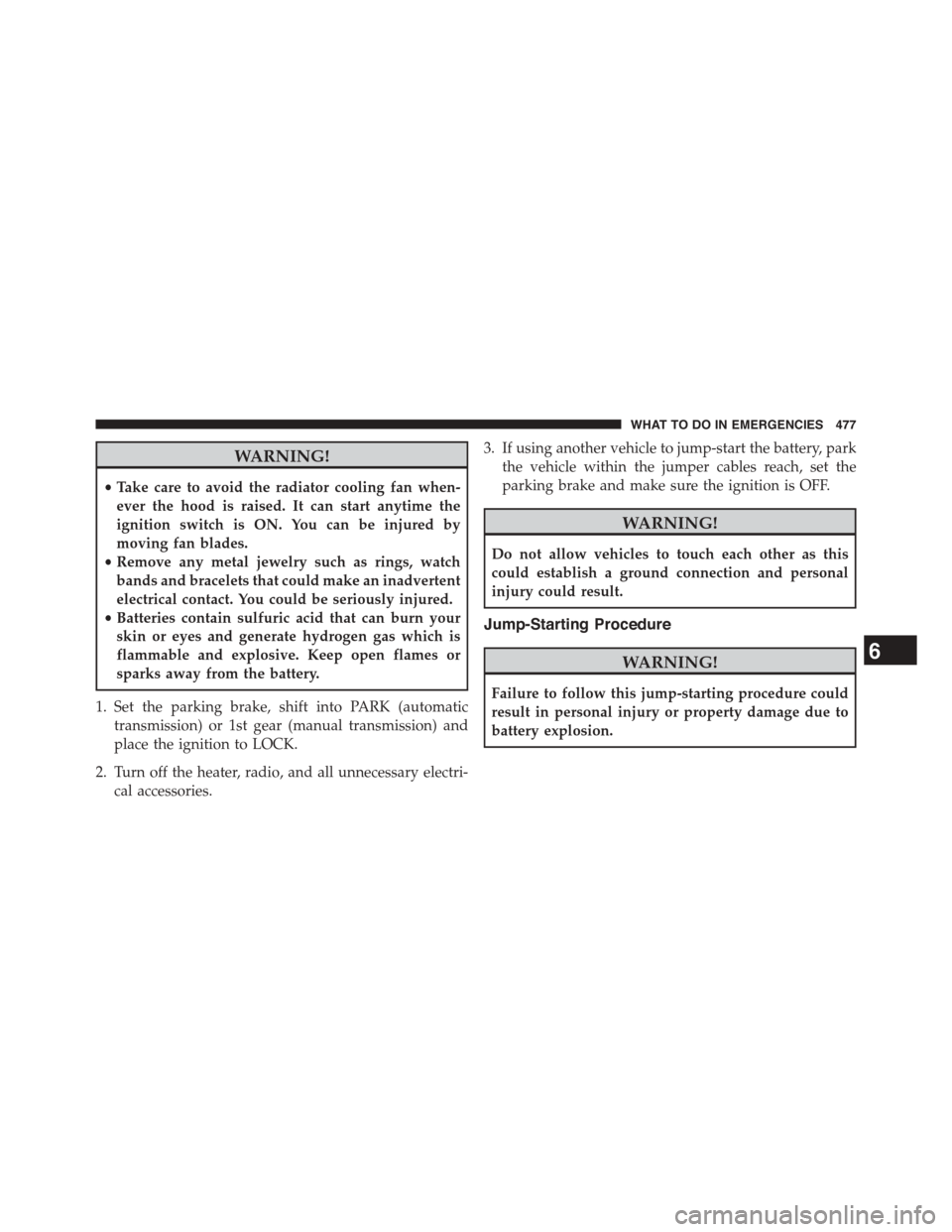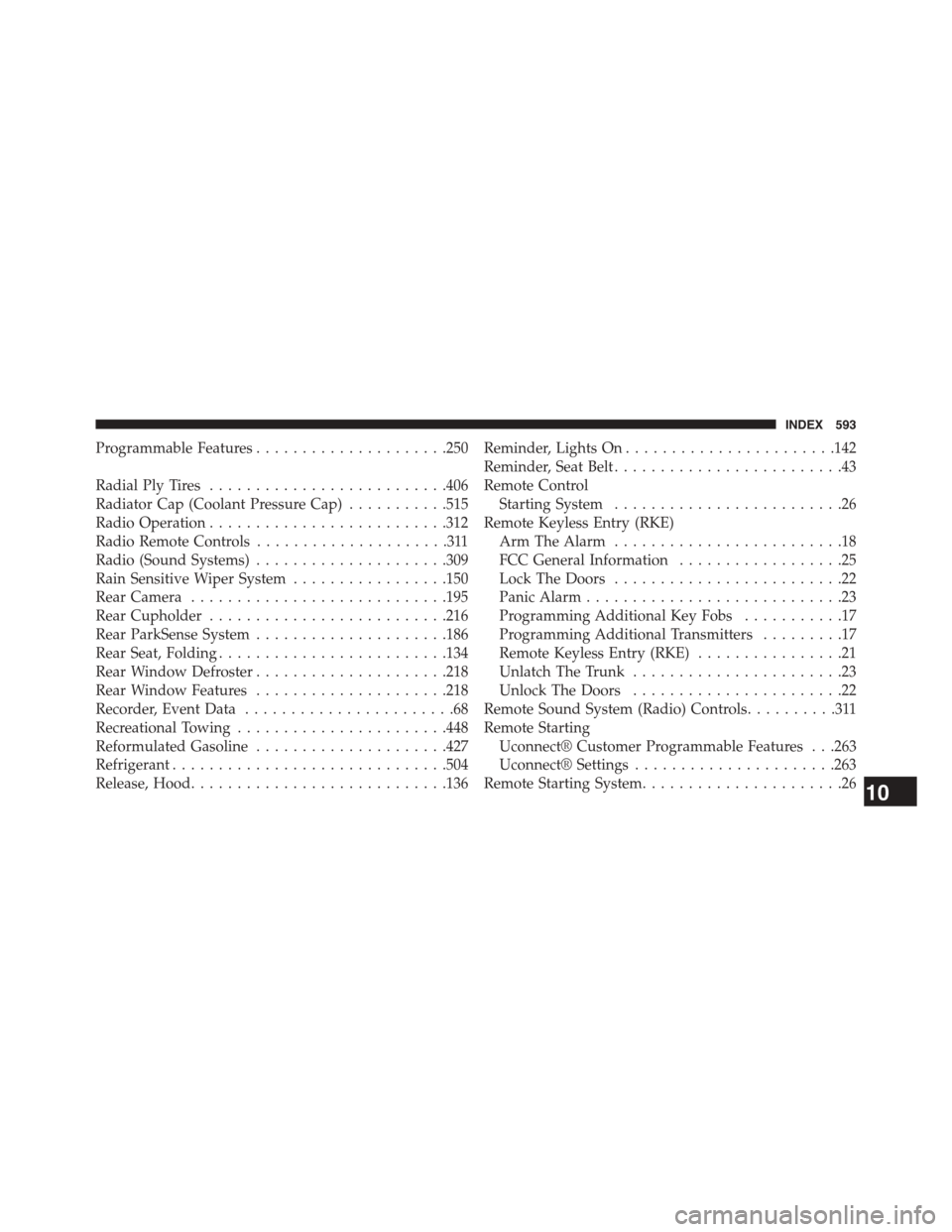Page 455 of 603

HAZARD WARNING FLASHERS
The Hazard Warning flasher switch is located on the
instrument panel, below the radio.
Press the switch to turn on the Hazard Warning
flasher. When the switch is activated, all direc-
tional turn signals will flash on and off to warn oncoming
traffic of an emergency. Press the switch a second time to
turn off the Hazard Warning flashers.
This is an emergency warning system and it should not
be used when the vehicle is in motion. Use it when your
vehicle is disabled and it is creating a safety hazard for
other motorists.
When you must leave the vehicle to seek assistance, the
Hazard Warning flashers will continue to operate even
though the ignition is placed in the OFF position.
NOTE:With extended use the Hazard Warning flashers
may wear down your battery.
IF YOUR ENGINE OVERHEATS
In any of the following situations, you can reduce the
potential for overheating by taking the appropriate ac-
tion.
•On the highways — slow down.
•In city traffic — while stopped, place the transmission
in NEUTRAL, but do not increase the engine idle
speed.
NOTE:There are steps that you can take to slow down
an impending overheat condition:
•If your air conditioner (A/C) is on, turn it off. The A/C
system adds heat to the engine cooling system and
turning the A/C off can help remove this heat.
•You can also turn the temperature control to maximum
heat, the mode control to floor and the blower control
to high. This allows the heater core to act as a
6
WHAT TO DO IN EMERGENCIES 453
Page 479 of 603

WARNING!
•Take care to avoid the radiator cooling fan when-
ever the hood is raised. It can start anytime the
ignition switch is ON. You can be injured by
moving fan blades.
•Remove any metal jewelry such as rings, watch
bands and bracelets that could make an inadvertent
electrical contact. You could be seriously injured.
•Batteries contain sulfuric acid that can burn your
skin or eyes and generate hydrogen gas which is
flammable and explosive. Keep open flames or
sparks away from the battery.
1. Set the parking brake, shift into PARK (automatic
transmission) or 1st gear (manual transmission) and
place the ignition to LOCK.
2. Turn off the heater, radio, and all unnecessary electri-
cal accessories.
3. If using another vehicle to jump-start the battery, park
the vehicle within the jumper cables reach, set the
parking brake and make sure the ignition is OFF.
WARNING!
Do not allow vehicles to touch each other as this
could establish a ground connection and personal
injury could result.
Jump-Starting Procedure
WARNING!
Failure to follow this jump-starting procedure could
result in personal injury or property damage due to
battery explosion.
6
WHAT TO DO IN EMERGENCIES 477
Page 530 of 603

Glass Surfaces
All glass surfaces should be cleaned on a regular basis
with MOPAR® Glass Cleaner, or any commercial
household-type glass cleaner. Never use an abrasive type
cleaner. Use caution when cleaning the inside rear win-
dow equipped with electric defrosters or the right rear
quarter window equipped with the radio antenna. Do
not use scrapers or other sharp instrument that may
scratch the elements.
When cleaning the rear view mirror, spray cleaner on the
towel or rag that you are using. Do not spray cleaner
directly on the mirror.
Cleaning Plastic Instrument Cluster Lenses
The lenses in front of the instruments in this vehicle are
molded in clear plastic. When cleaning the lenses, care
must be taken to avoid scratching the plastic.
1. Clean with a wet soft rag. A mild soap solution may be
used, but do not use high alcohol content or abrasive
cleaners. If soap is used, wipe clean with a clean damp
rag.
2. Dry with a soft cloth.
Seat Belt Maintenance
Do not bleach, dye, or clean the belts with chemical
solvents or abrasive cleaners. This will weaken the fabric.
Sun damage can also weaken the fabric.
If the belts need cleaning, use MOPAR® Total Clean, a
mild soap solution, or lukewarm water. Do not remove
the belts from the vehicle to wash them. Dry with a soft
cloth.
Replace the belts if they appear frayed or worn or if the
buckles do not work properly.
528 MAINTAINING YOUR VEHICLE
Page 540 of 603
Cavity Cartridge FuseMini-FuseDescription
1620 Amp Blue—Left Spot Lamp – Police
17——Fuse – Spare
1820 Amp Blue—Active Dampening Module – If
Equipped
19——Fuse — Spare
20——Fuse — Spare
2130 Amp Pink—Fuel Pump (LD 6.2L Supercharged)
22—20 Amp Yellow Right Spot Lamp – Police
23—10 Amp Red Fuel Door/Diagnostic Port
24—15 Amp Blue Radio Screen
25—10 Amp Red Tire Pressure Monitor
26—15 Amp Blue
25 Amp Clear
30 Amp Green
Transmission (LD/LX)
Fuel Pump (LA)
Fuel Pump (LA 6.2L Supercharged)
27—25 Amp Clear Amplifier / Spare – If Equipped
538 MAINTAINING YOUR VEHICLE
Page 541 of 603
Cavity Cartridge FuseMini-FuseDescription
31—25 Amp Clear Power Seats
32—15 Amp Blue HVAC Module/Cluster
33—15 Amp Blue Ignition Switch/Wireless Module
34—10 Amp Red Steering Column Module/Clock/Spare
– Police
35—5 Amp TanBattery Sensor
36—15 Amp Blue Electronic Exhaust Valve – If Equipped
37—15 Amp Blue Radio
38—20 Amp Yellow Power Outlet Inside Arm Rest
40——Fuse — Spare
41——Fuse — Spare
4230 Amp Pink—Rear Defrost
43—20 Amp Yellow Rear Heated Seats/Steering Wheel
44—10 Amp Red Park Assist/Blind Spot/Camera
45—15 Amp Blue Cluster/Rearview Mirror/Compass
7
MAINTAINING YOUR VEHICLE 539
Page 595 of 603

Programmable Features.....................250
Radial Ply Tires..........................406
Radiator Cap (Coolant Pressure Cap)...........515
Radio Operation..........................312
Radio Remote Controls.....................311
Radio (Sound Systems).....................309
Rain Sensitive Wiper System.................150
Rear Camera............................195
Rear Cupholder..........................216
Rear ParkSense System.....................186
Rear Seat, Folding.........................134
Rear Window Defroster.....................218
Rear Window Features.....................218
Recorder, Event Data.......................68
Recreational Towing.......................448
Reformulated Gasoline.....................427
Refrigerant..............................504
Release, Hood............................136
Reminder, Lights On.......................142
Reminder, Seat Belt.........................43
Remote Control
Starting System.........................26
Remote Keyless Entry (RKE)
Arm The Alarm.........................18
FCC General Information..................25
Lock The Doors.........................22
Panic Alarm............................23
Programming Additional Key Fobs...........17
Programming Additional Transmitters.........17
Remote Keyless Entry (RKE)................21
Unlatch The Trunk.......................23
Unlock The Doors.......................22
Remote Sound System (Radio) Controls..........311
Remote Starting
Uconnect® Customer Programmable Features . . .263
Uconnect® Settings......................263
Remote Starting System......................2610
INDEX 593
Page 602 of 603

INSTALLATION OF RADIO TRANSMITTING
EQUIPMENT
Special design considerations are incorporated into this
vehicle’s electronic system to provide immunity to radio
frequency signals. Mobile two-way radios and telephone
equipment must be installed properly by trained person-
nel. The following must be observed during installation.
The positive power connection should be made directly
to the battery and fused as close to the battery as possible.
The negative power connection should be made to body
sheet metal adjacent to the negative battery connection.
This connection should not be fused.
Antennas for two-way radios should be mounted on the
roof or the rear area of the vehicle. Care should be used
in mounting antennas with magnet bases. Magnets may
affect the accuracy or operation of the compass on
vehicles so equipped.
The antenna cable should be as short as practical and
routed away from the vehicle wiring when possible. Use
only fully shielded coaxial cable.
Carefully match the antenna and cable to the radio to
ensure a low Standing Wave Ratio (SWR).
Mobile radio equipment with output power greater than
normal may require special precautions.
All installations should be checked for possible interfer-
ence between the communications equipment and the
vehicle’s electronic systems.